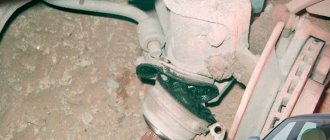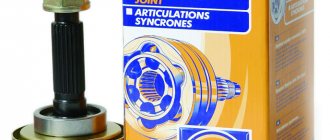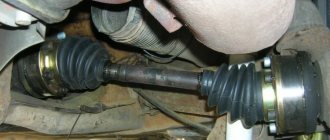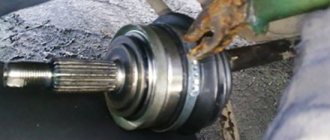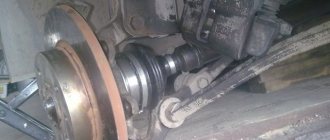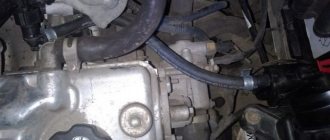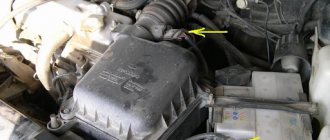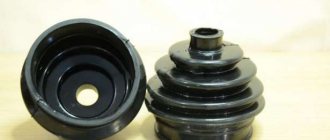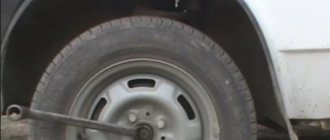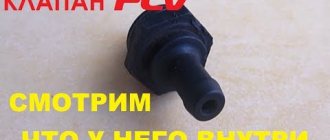Replacing the outer CV joint of a VAZ 2114
Hi all. We will replace the outer CV joint of the VAZ 2114. This is not a difficult job; if you have the tools, you can do it yourself.
Tools:
- good wrench and head for thirty
- hammer and screwdriver to hit
- pipe
- wooden block
- universal tongs and pliers
Vendor code:
- 2108-2215012 — external CV joint. I recommend installing a CV joint from GKN-Spidan, Loebro.
Step by step replacement
1. Remove the decorative cover of the hub nut and flare it.
2. We rip off the hub nut, if you can’t rip it off, then put the pipe on the knob for the lever.
3. Remove the wheel.
4. Unscrew the 2 ball fastening bolts.
5. Completely unscrew the hub nut.
6. Remove the rubber band securing the brake hose from the groove and pull the hub towards you so that the CV joint comes out of the hub.
7. As a rule, the boot is already torn, so we place the pipe on the inside of the CV joint and knock it out of its seat.
8. Remove the metal ring on the drive shaft. This ring comes with the new CV joint and needs to be replaced.
9. Fill the CV joint with lubricant, it is included in the kit.
10. We put the ring on the drive shaft.
11. We put on the boot, lightly coated with the same lubricant as in the CV joint.
12. We put the CV joint on the splines on the drive shaft and stuff it through a wooden adapter.
13. Move the boot closer to the CV joint and secure one side of the boot with a clamp. Tighten the clamp using pliers.
14. Fix the other side of the boot with a clamp. Tighten the clamp with pliers.
15. Mount the CV joint into the hub. Install the washer and tighten the hub nut. All this comes new complete with CV joint.
16. Fasten the two ball bolts. Use a pry bar to press the lever down and align the ball mounting holes.
Do everything slowly so as not to tear the new boot.
17. Install the rubber band into the groove that secures the brake hose.
18. Install the wheel and remove the car from the jack.
19. Tighten the hub nut.
20. Raise the car and remove the wheel.
21. Roll the nut and install the wheel.
Transmission device diagram
The gearbox mechanism is a system of parts that has an independent structure and characteristic features determined by the model. Before you begin repairing the gearbox, you must familiarize yourself with the diagram of the transmission mechanism in the operating manual. The diagram contains the names of the parts and the structure of the relationship.
Transmission device: 1 - input shaft; 2 - secondary shaft; 3 — rod for shifting the third and fourth gears; 4 — fork for shifting third and fourth gears; 5 — differential; 6 — fork for switching first and second gears; 7 — fork rod for shifting first and second gears; 8 — gear shift rod; 9 — fifth gear shift fork rod; 10 — gear shift mechanism; 11 — reverse intermediate gear; 12 — clutch housing
Knowledge of the structure of the structure reduces the time spent on identifying mounting fasteners and dismantling components.
Replacing the inner and outer CV joints on a VAZ 2114
Knocks in the chassis are a frequent companion in life for VAZ 2114 owners. Many elements that can cause knocking, bad roads, and low-quality parts can cause extraneous noise in the suspension.
A common source of the problem is the angular velocity distributor, or CV joint (grenade). The process of replacing a part is simple, so you can change it yourself. The question is often asked which CV joint for the VAZ 2114 is better: regular or tripoid. Among the most common arguments: tripoid is more reliable, but it hums and vibrates at high speeds. The regular one is less reliable, but the car handles better at high speed. However, you can find opposing opinions and arguments on this matter.
There is no clear answer which type is better. Operation in harsh conditions showed that there is no fundamental difference in driving sensations and reliability. The main thing is to buy a high-quality grenade made of well-hardened metal, install it correctly and monitor the safety of the anthers.
Scheme for disassembling the VAZ 2114 CV joint
Causes of malfunction
Among the main causes of CV joint failure:
- low quality metal and lubricant;
- insufficient amount of lubricant;
- rupture of the boot, entry of dirt.
The CV joint is a moving element, so it heats up when moving. A lack of lubricant or its lack of the necessary properties leads to wear of the hinges and the appearance of extraneous sounds. Due to the rupture of the boot, dirt gets into the grenade, solid particles harm the moving elements.
Fault diagnosis
The VAZ 2114 has 2 external and 2 internal CV joints. First you need to determine which one is knocking. The optimal test would be on a suspension diagnostic stand. If this is not possible, diagnosis by ear is possible.
Two signs indicate a grenade malfunction in a VAZ 2114:
- the sound resembles a crunch;
- It usually appears when turning.
The simplest and most accurate way to do a garage check is as follows:
- Place the car on a flat surface;
- Turn the wheels to one side (to the middle position or a little further);
- Drive off with medium speed. It is worth remembering that starting too smoothly may not reveal a crunch due to insufficient load on the CV joint, and starting too abruptly may lead to the drive flying out of the wheel.
- Repeat the operation by turning the steering wheel in the other direction. The appearance of a crunch indicates a malfunction of the outer CV joint on the side in which the steering wheel is turned.
Visual detection of ruptured anthers will also be a sign of a CV joint failure. If you discover a damaged protection for any grenade, it must be immediately removed, disassembled and cleaned. If there is enough grease and there is no significant wear on the hinges yet, it is enough to replace the boot and fill it with new grease. If the wear of the balls is obvious, it is better to change the grenade.
CV joint boot VAZ 2114 with a defect
It is more difficult to diagnose a malfunction of the internal grenade on a VAZ 2114. If it malfunctions, it crunches when starting off in a straight direction, and not when turning. But the same symptoms, for example, include play in the steering rack or wear on the engine mounts.
Sometimes the problem can be diagnosed from the pit by tugging on the drive from the gearbox side: strong play or the appearance of extraneous sounds indicate that the internal CV joint should be replaced.
Replacement
It is better to change a grenade yourself with an assistant.
Algorithm:
- remove the wheel, remove the wheel bolts and the hub nut washer;
- unscrew the ball from the steering knuckle;
- pull out the splined end of the outer CV joint;
- pull out the drive with the internal CV joint from the gearbox;
- if you plan to remove both drives, remove the internal grenade from the drive and insert it into the gearbox so that the differential does not move after removing the second drive;
- remove or cut off the anthers, thoroughly clean all hinges with a special liquid or just gasoline;
- when filling the CV joint, use a special lubricant suitable for these purposes; ordinary lithol does not have the required temperature characteristics;
- the retaining rings of each CV joint and the hub nut must be replaced;
- The inner CV joints are inserted into the gearbox until they are completely fixed; when adjusting, you can use a hammer with a wooden spacer.
It is quite possible to diagnose and replace a CV joint with your own hands. This does not require sophisticated car mechanic skills and engineering knowledge, but it allows you to get in touch with the car, see and feel how it works. Whatever the reason for the crunching sound, you need to check the condition of the grenade as quickly as possible. Delaying this will almost certainly mean bringing the part to the point of complete wear, and timely repairs will allow you to get by with “little loss.”
how to insert the drive into the box
how to insert the drive into the box
Post by diablo36 »12 Oct 2014 15:06» Post # 400539
Re: how to insert the drive into the box
Post by diablo36 10/12/2014 3:08 pm Post # 400540
Posted by aerelf Oct 12, 2014 3:52 pm Post # 400544
Re: how to insert the drive into the box
Post by diablo36 10/12/2014 4:15 pm Post # 400548
Posted by aerelf » 10/12/2014 6:08 pm » Post # 400562
Re: how to insert the drive into the box
Posted by Jonny1602 Oct 12, 2014 6:11 pm Post #400564
If it stands up (the lock is unlocked), you will hear it, but it’s better not to pull: there is a tripod and by pulling the unit, you will tear the boot (only it holds it) faster than pulling out the unit. To remove them, they are usually hooked to the box with a chisel (with a chisel. I inserted them with my hands - I didn’t have to hammer anything in.
Re: how to insert the drive into the box
Posted by Jonny1602 Oct 12, 2014 6:14 pm Post #400565
Message by aerelf »10/12/2014 6:19 pm» Post # 400566
Re: how to insert the drive into the box
Posted by Jonny1602 October 12, 2014 06:25 PM 400568
Posted by aerelf » October 13, 2014 08:08 am » Posted by n. 400620
Replacing the outer CV joint boot of a VAZ 2114
Yesterday late at night I came from the garage, as in that song “Tired, hungry and angry, but very pleased with myself!” Anthers have been replaced. And it was like this.
So for work we need:
- CV boots - 2 pcs.;
- Anther clamps - 4 pcs;
- Hub nuts - 2 pcs;
- CV joint grease - 1 tube;
- Head for 30 (I took it with touch control using a crowbar) - 1 piece;
- Well, and a bunch of other tools (wrench, tweezers, chisel, hammer, vocabulary of obscenities, etc.)
Work plan
So, let's begin. We remove the cap from the wheel (those who don’t have it have less work), remove the hub nut cap. Unscrew the nut, I used a dowel, take a 30mm socket and loosen the hub nut. Then loosen the wheel bolts.
All this needs to be unscrewed
We jack up the car and remove the wheel, immediately put it under the car (just in case), and unscrew the hub nut.
Unscrewed
We unscrew the bolts securing the ball joint to the steering knuckle (I unscrewed it with a balloon)
Those that are higher
We press the lever down using a crowbar, hold it in this position with your knee, and at this time we move the steering knuckle and pull the drive out of the hub (after turning the steering wheel to the left). Cutting off the old boot
Drive pulled
Well, then it’s time to remove the CV joint from the shaft. I read that it can be removed by lightly tapping the inside. It wasn't like that. I remembered all my swear words, but it didn’t do any good. It was too late to go to the store for a puller, so I took out a welding tool and invented a puller. With his help, the CV joint was removed within five minutes. But I couldn’t do anything with a hammer in two hours.
Here's a simple helper
After that, we take gasoline and thoroughly wash the CV joint, at least to this condition
It’s clean, and most importantly, it can be easily tossed and turned in all directions.
Well, then we apply grease inside, put the boot on the shaft and put the CV joint in place. To do this, we screw on the old nut and, with a short but sharp blow of a hammer, drive it until the thrust washer. We put the boot on the CV joint and secure it on both sides with clamps. We put the drive in the hub and attach a new nut.
Collected.
Next, install the wheel, lower the car and tighten the hub nut with the same force as it was unscrewed. And don’t forget to seal it
Energized. I used a dull chisel for this.
We repeat the same procedure on the right wheel. That's basically it, the boots have been replaced, the car is running, I now have a puller for CV joints and invaluable experience in removing them.
Tags: problems with gearbox
Comments 72
guys, help me buy a new all-wheel drive drive shaft, we installed everything on the VAZ2109 as written in the book. But when I got out and drove a couple of miles, the inner CV joint came off with a small jump. And I can't get into any gear. What could be the reason... Thanks in advance
Thank you all guys, I’m very tired, I’ll go to bed tomorrow, I’ll try again
The main thing is not to lose heart =) everything will be fixed!
but where will it go to us! Only today was the last day off (he was on sick leave) and the car is in a friend’s garage! and he needs it too!
Tomorrow I’ll look at myself and erase =) again, don’t give up - everything is fine, tomorrow let me know what can be done with the measurements and samples that I wrote to you =)
Thanks again everyone! Today I bought a new retaining ring, washed the flange on a grenade, sharpened it with a file and imagine how you sit down! Hooray! WE ALL WON! What would I do without you all!
The main task during assembly is to ensure that the holes inside these very gears opposite the holes in the gearbox housing are immediately cleaned - the splines are visible when inspected or touched by hand.
in general: image - www.mkad86.ru/acat/data/vaz/2109/v410.gif an axis is drawn on it in the center, there are two gears on it (one is drawn below) they will not go anywhere and will remain so insert the drive shafts into the gears (art. -2108-2303050) - they can turn over, but they do not peel off.
I split my body so much...
also unclear. In general, you can’t remove two disks, that’s it - I took one out and put the chopper back in place. and then remove the other disk. Reassemble in reverse order... If you don't do this, it's a penny. the differential will just fall apart
can! well you're scary
there is a closed system of gears that does not cling to anything except the grenade rods, you take out both grenades and everything crumbles...
in fact, there is an axis of the satellites; they transmit torque from the differential to the gears, which are mounted on the axle shafts. Only these gears can spin there (in the figure above they are indicated by the number 5) and nothing is destroyed there.
How to change the CV joint on a VAZ 2114
Replacing CV joints on VAZ 2115, VAZ 2114, VAZ 2113
In front-wheel drive cars, one of the most problematic areas is the constant velocity joints. Abbreviated as CV joint or "grenade". The CV joint is a kind of ball bearing; its races have transverse grooves, which allows you to change the angle between the drive and driven axle shafts. All elements of the CV joint are made of ultra-strong alloys, the wear of which occurs extremely slowly, but, as practice shows, signs of a CV joint malfunction can appear even in a car that has recently left the assembly line of a car plant.
On cars of the VAZ family, it often becomes unusable after
55,000 km .
Causes and symptoms of CV joint failure on a VAZ 2115
The most common reasons:
- low quality CV joints, installation of fakes or defective spare parts;
- lack or poor quality of lubricants;
- damage to the boot and entry of abrasive debris or water into the mechanism;
- aggressive driving style and disgusting condition of the road surface.
One of the signs of replacing a VAZ 2114 CV joint is the appearance of a characteristic “crunch” . This sound can only be produced by balls that roll along grooves, because... have too much output. Working in close contact under constant load inevitably leads to changes in the properties of rubbing parts, their sizes, and the formation of wear.
Where there is no close contact of these elements and extraneous noise appears. The sound can appear at any time, but usually it occurs when turning, sharp acceleration, or overcoming obstacles. There are other signs indicating a hinge failure :
- slight jerks when starting the car or changing dynamics;
- play of the shaft located between the CV joints when trying to move it in different planes.
Which brand of grenade should I choose?
When searching for components, you should approach their selection with care. The CV joint is the main part of the car's drive and often fails, so you should choose a spare part not only for reasons of price, but also quality.
It’s better to find the original; look carefully at the box in which the CV joint is sold, as you can often find a very high-quality fake. Also pay attention to the part number, it should be 2108-2215056 . The average price is about 2000 rubles .
When considering certified analog spare parts for purchase, you should look at the quality of workmanship. Even reading most of the positive reviews about a particular brand, you should not exclude the percentage of defects, which always exists.
Universal diagnostic method
Diagnosis of a malfunction of the internal CV joint
We present to you an algorithm for another, universal option, how to find out which “grenade” is crunchy. You need to act in the following sequence:
- Place the car wheels level.
- Raise one of the front wheels using a jack.
- Put the car on the handbrake and neutral gear.
- Start the engine, depress the clutch, engage first gear and slowly release the clutch, that is, “move off” (as a result, the suspended wheel will begin to rotate).
- Slowly press the brake pedal, creating a natural load on the joint. If one of the internal “grenades” is faulty, then at this time you will hear familiar knocking sounds on the left or right side. If the internal CV joints are in order, then the car will simply start to stall.
- Turn the steering wheel all the way to the left. Slowly press the brake pedal. If the internal “grenade” is faulty, it will continue to knock. If the outer left CV joint is also faulty, then sound will also be added from it.
- Turn the steering wheel all the way to the right. Carry out similar procedures. If a knocking noise occurs when the steering wheel is turned to the right, it means that the right outer joint is faulty.
- Be sure to put the gear in neutral, turn off the engine, and wait until the wheel comes to a complete stop before lowering it to the ground.
